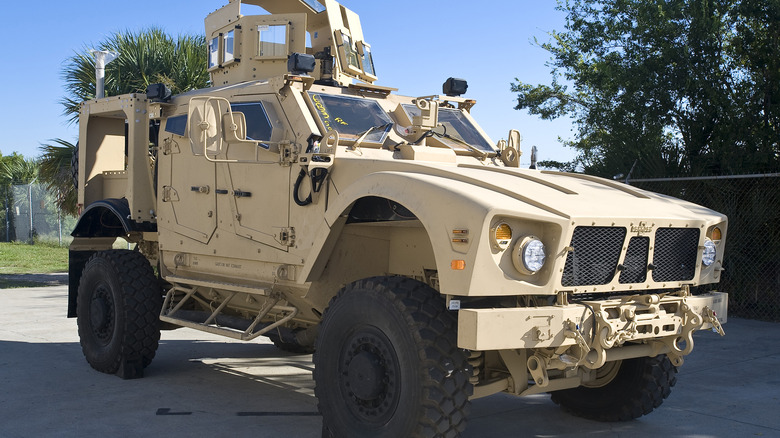How The MRAP Was Built To Survive Massive Explosions
In 1984, the High Mobility Multipurpose Wheeled Vehicle (also known as the Humvee) replaced the U.S. Army's tried and true tactical vehicle, the M151 Jeep. It first served in Operation Just Cause during the US invasion of Panama in 1989 and gained much greater recognition a year later in the Gulf War.
The Humvee served as a primary tactical vehicle for the better part of the next two decades. As enemy tactics changed, the Army added even more armor to something that was only meant to be lightly armored to begin with. Improvised explosive devices (IEDs) embedded in the ground were problematic because they directed attacks at the most vulnerable spot on the Humvee – its underside. As the IED threat grew, the military added additional armor to the flat-bottomed Humvees, but that still didn't adequately protect the troops inside.
So the military chose to use an entirely different type of vehicle known as an MRAP, or Mine-Resistant, Ambush-Protected armored vehicle, to combat the issue. What makes an MRAP so much different from a Humvee is the design of the undercarriage.
The Rhodesian and South African armies had used early versions as far back as the 1970s. In 2004, Force Protection, Inc. unveiled its first MRAP based on similar designs that used a V-shaped belly named the COUGAR.
V is for victory. And survival.
In 2006, Marine Corps Systems Command initiated the MRAP Joint Program Office, which brought together U.S. Marines, Army, Navy, and special operations units to get the MRAPs fielded as fast as possible. The Department of Defense (DOD) joined the effort a year later.
The old Humvees had flat bottoms, much like standard commercial vehicles. This made them perfect targets for explosives. When a Humvee rolled over an IED, the force of the blast would hit the underside (that lay horizontal to the ground) at full strength.
MRAPs —instead of a conventional flat belly — have a V-shaped armor-plated hull specifically intended to deflect explosions up and away from the vehicle. Military sources claim this offers 10 times the protection. They also have a raised chassis that helps reduce fragmentation, blast overpressure, and acceleration of an IED explosion. Additionally, they can be fitted with extra layers of armor that can even protect against RPG rounds.
The are four MRAP categories (I, II, III and M-ATV). Category I is the smallest and works in urban combat scenarios and for casualty evacuation. Category II is for convoys and troops carriage, while Category III sweeps for mines and IEDs. The MRAP-All Terrain Vehicle (M-ATV) is the most mobile of the bunch and was designed for use in extreme conditions.
According to Aeroweb, "Seven different vehicle designs have been purchased from five different contractors, including BAE Systems, Force Protection Industries (FPI), General Dynamics Land Systems (GDLS), NAVISTAR Defense, and Oshkosh Corporation."
